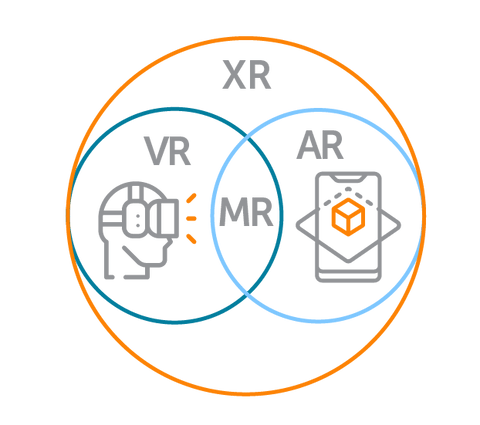What is VR?
Virtual Reality (VR) can be defined as a computer-generated environment delivered to the user in a way that is designed to suspend reality through immersing the senses. In other words, VR hacks into the senses by blocking out the real world and immersing the user in a simulated one.
A VR headset or Head Mounted Display (HMD) is the technology used to deliver a VR experience. It is a helmet-like device that covers the eyes and shows visuals to the user via screens inside the headset. Sensors also track the movement of the head, so that moving your head produces the same movement in the virtual environment shown on-screen. This enables you to look around the virtual world in the same way you would in the real world.
Additional hardware like headphones, sensors that track movement of the body and tactile feedback devices can all be incorporated to increase the realism and immersion of the experience.
What is AR, MR, and XR?
Extended Reality (XR) is an umbrella term encapsulating a range of related technologies, from Virtual Reality (VR), which we’ve already discussed, to Augmented Reality (AR), Mixed Reality (MR), and everything in-between.
Whereas VR attempts to block out the external environment, AR uses the external environment by laying digital content over a live feed of the environment being viewed through a device. For example, you might use the camera on a device like a smartphone to view your surroundings on-screen, then the AR software will overlay computer generated content onto the world being seen through the smartphone.

Source: ResearchGate
So while you can see VR as trying to replace the reality you are in, AR works by adding to the reality you are seeing rather than replacing it. Then there is MR, which also goes by the name hybrid reality or extended reality. This is similar to AR in that it blends the real world with the virtual world but with the difference being that the content can interact with the environment.
You can think of MR as a more sophisticated form of AR. With MR, the software maps the physical real-world environment and aligns the digital content with these physical elements so that the digital content can interact with it.
For example, both AR and MR can produce an anatomical model of the heart to appear in the user's environment. However, MR could take the experience a step further by allowing the user to reach out into physical space and manipulate the model using their hands.
What is the metaverse?
The metaverse is harder to define because it isn’t fully realised yet and doesn’t relate to a certain type of technology. One way to think of the metaverse is a broad term that refers to an integrated network of 3D virtual communities. Perhaps one of the closest examples we currently have of the metaverse is the simulation game, Second Life.
Second Life is a parallel digital world where users create their own virtual avatar and use it to do many things that can be done in real life, from shopping and eating, to attending college or buying land. The metaverse is similar to this but will be broader in its scope and use XR technologies so that users can experience a hyper-realistic 3D environment to work, shop, play and socialise.
Another way you can think of the metaverse is being like the internet. The internet provides a digital space for people to do many things, including working, gaming, shopping, and socialising. If you were to order a pair of shoes online, you would probably search for the store website, view pictures of the shoes, read their description, and click a link to purchase them.
The metaverse will be able to offer these same features but instead it will feel like being inside the internet. So through the use of immersive technology like a VR headset, I could visit a 3D virtual store, browse the products by using my head to look around and then using motion controllers, get my digital avatar to pick up the shoes and try them on before buying.
As a company dedicated to providing innovative and original content, we pride ourselves in also working with influencers that amplify this dedication. Therefore we are honored to collaborate with Tony from VR Reviews helping us to share the latest virtual reality news on our website, please click image below to find out more.


